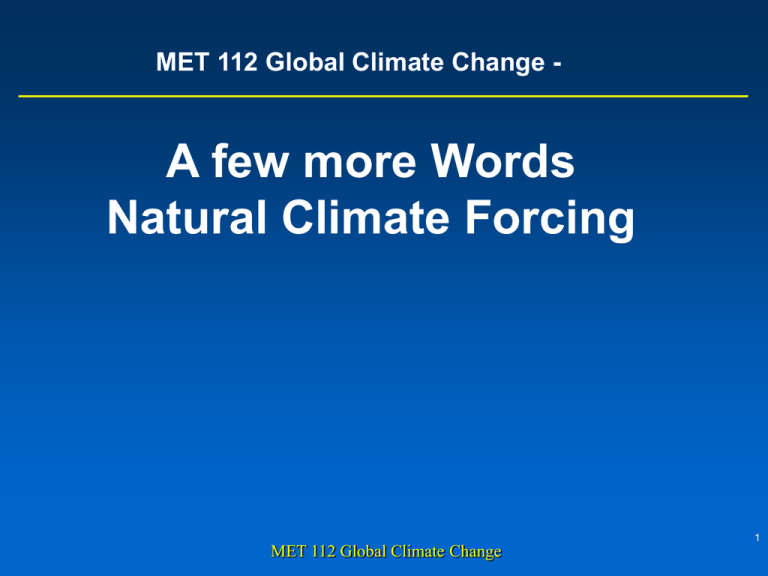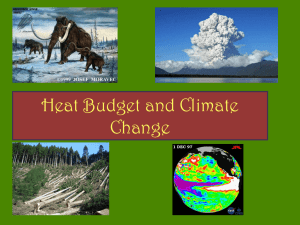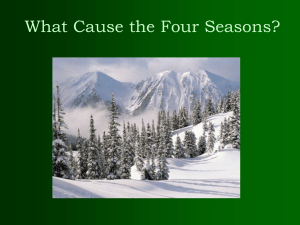METO112-naturalforcing
advertisement

MET 112 Global Climate Change - A few more Words Natural Climate Forcing 1 MET 112 Global Climate Change External Forcing Variations in solar output Orbital variations Meteors 2 MET 112 Global Climate Change SOLAR ACTIVITY Sunspots are the most familiar type of solar activity. THE SOLAR CYCLE Sunspot numbers increase and decrease – over an 11-year cycle Observed for centuries. Individual spots last from a few hours to months. Studies show the Sun is in fact about – 0.1% brighter when solar activity is high. Climate Change and Variations in Solar Output Sunspots – magnetic storms on the sun that show up as dark region Maximum sunspots, maximum emission (11 years) Maunder minimum – 1645 to 1715 when few sunspots happened 5 MET 112 Global Climate Change THE MAUNDER MINIMUM An absence of sunspots was well observed – from 1645 to 1715. The so-called “Maunder minimum” coincided with a cool climatic period in Europe and North America: – “Little Ice Age” The Maunder Minimum was not unique. Increased medieval activity – correlated with climate change. 6 MET 112 Global Climate Change Climate During the Past 1000 Years Little Ice Age 1816 – “Year Without A summer” Very cold summer followed by extremely cold winter 7 MET 112 Global Climate Change The Year Without Summer The Year Without a Summer (also known as the Poverty Year, Eighteen Hundred and Froze to Death, and the Year There Was No Summer) was 1816, in which severe summer climate abnormalities destroyed crops in Northern Europe, the Northeastern United States and eastern Canada. Historian John D. Post has called this "the last great subsistence crisis in the Western world". Most consider the climate anomaly to have been caused by a combination of a historic low in solar activity and a volcanic winter event; the latter caused by a succession of major volcanic eruptions capped off by the Mount Tambora eruption of 1815, the largest known eruption in over 1,600 years. 8 MET 112 Global Climate Change the 1815 (April 5–15) volcanic eruptions of Mount Tambora[8][9] on the island of Sumbawa, Indonesia 9 MET 112 Global Climate Change Climate Change and Atmospheric Particles Sulfate aerosols – Put into the atmosphere by sulfur fossil fuels and volcanoes • Mount Pinatubo is an active stratovolcano located on the island of • Luzon, at the intersection of the borders of the Philippine provinces. • Its eruption occurred MET in June 1991 112 Global Climate Change 10 Orbital changes Milankovitch theory: Serbian astrophysicist in 1920’s who studied effects of solar radiation on the irregularity of ice ages Variations in the Earth’s orbit – Changes in shape of the earth’s orbit around sun: Eccentricity (100,000 years) – Wobbling of the earth’s axis of rotation: Precession (22,000 years) – Changes in the tilt of earth’s axis: Obliquity (41,000 years) 11 MET 112 Global Climate Change Climate Change and Variations in the Earth’s Orbit Eccentricity – Change in the shape of the orbit (from circular to elliptical – Cycle is 100,000 years – More elliptical, more variation in solar radiation Presently in Low eccentricity 12 MET 112 Global Climate Change Eccentricity affects seasons Small eccentricity --> 7% energy difference between summer and winter Large eccentricity --> 20% energy difference between summer and winter Large eccentricity also changes the length of the seasons 13 MET 112 Global Climate Change Climate Change and Variations in the Earth’s Orbit Procession – Wobble of the Earth as it spins – The Earth wobbles like a top – Currently, closest to the sun in January – In 11,000 years, closest to the sun in July 14 MET 112 Global Climate Change Axis tilt: period ~ 41,000 years 16 MET 112 Global Climate Change 17 MET 112 Global Climate Change Obliquity explain seasonal variations Ranges from 21.5 to 24.5 with current value of 23.439281 Small tilt = less seasonal variation cooler summers (less snow melt), warmer winters -> more snowfall because air can hold more moisture Source: http://www.solarviews.com/cap/misc/obliquity.htm Temperature: the last 400,000 years From the Vostok ice core (Antarctica) Fig 4.5 High summer sunshine, lower ice volume Internal Forcing Plate tectonics/mountain building ____________________________ Volcanoes ____________________________ Ocean changes Chemical changes in the atmosphere (i.e. CO2) – Natural variations 21 MET 112 Global Climate Change Activity Consider the fact that today, the perihelion of the Earth’s orbit around the sun occurs in the Northern Hemisphere winter. In 11,000 years, the perihelion will occur during Northern Hemisphere summer. A) Explain how the climate (i.e. temperature of summer compared to temperature of winter) of the Northern Hemisphere would change in 11,000 years just due to the precession. B) How would this affect the presence of Northern Hemisphere glaciers (growing or decaying)? Assume growth is largely controlled by summer temperature. 22 MET 112 Global Climate Change Earth’s orbit: an ellipse • Perihelion: place in the orbit closest to the Sun • Aphelion: place in the orbit farthest from the Sun 23 MET 112 Global Climate Change Precession: period ~ 22,000 years 24 MET 112 Global Climate Change Seasonal weather patterns are shaped primarily by the 23.5-degree tilt of our planet's spin axis, not by Earth's elliptical orbit. explains George Lebo, a professor of astronomy at the University of Florida. "During northern winter the north pole is tilted away from the Sun. Days are short and that makes it cold. The fact that we're a little closer to the Sun in January doesn't make much difference. It's still chilly -- even here in Florida!" http://science.nasa.gov/headlines/y2001/ast04jan_1.htm 25 MET 112 Global Climate Change If the earth’s tilt was to decrease, how would the summer temperature change at our latitude 1. Warmer summer 2. Cooler summer 3. Summer would stay the same 4. Impossible to tell A: How would climate change 1. Warmer winters, cooler summers 2. Warmer winters, warmer summers 3. Cooler winters, warmer summers 4. Cooler winter, cooler summer 27 MET 112 Global Climate Change B: How would glaciers change? 1. Glaciers would grow 2. Glaciers would decay 3. Glaciers would stay about constant 28 MET 112 Global Climate Change











